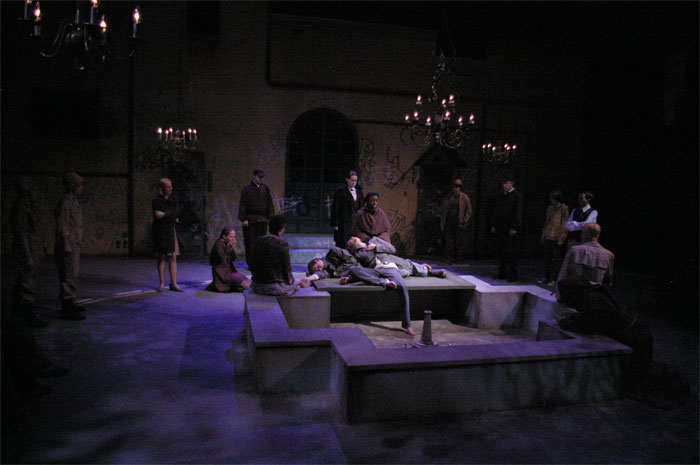
Romeo & Juliet--Theatre Fairfield
"You work magic with the lights every time. I loved the texture you had on the "grass," and the warm glow at the final moments took my breath away the first time I saw it...You are a class act."
-Julie Leavitt
-costume designer, Dancing at Lughnasa
-Theatre Fairfield
"Thank you, thank you, thank you for the magical and seemingly effortless way you have with lights...it is, as always, simply beautiful!"
-Dawn McAndrews
-Producing Artistic Director
-Theater at Monmouth
"Lynne you've done it again. It is beautiful! Thank you for being so open and talented. I love to watch you work. Congrats!"
-Sally Wood
-affiliate artist, Portland Stage Company
-director Taming of the Shrew
-Theater at Monmouth
Bold Nuance
Lighting can be so many things. It all depends on the play.
Lighting is about making the actors look good and stand out.
But
Lighting can be about hiding characters or throwing them into silhouette.
Lighting can be about giving the stage a richness.
Yet
Lighting can be about making the stage look desolate, stark, harsh or uncomfortable.
Lighting can be about making the set look it's best and emphasizing what's best in the set.
However
Lighting can also be about changing the way the set looks to help establish changes in place, emotion or time.
So, lighting, for me, is about aiding the story.
It's about helping the playwright, the director and the actors to tell the story the audience is watching.
It's about crafting the way that we see the actors.
It's also about crafting the way that we see the set. The set and the lighting work together hand in glove.
It's about fitting the needed lighting changes into the movement of the piece so that the light ends a scene without stepping on the actor's last line or so that we understand that time has passed or that we are in a new location.
It's also about synthesis. It's about pulling together the needs of the play, the director's ideas, the theatre architecture, the possibilities and limitations of the set, the schedule and the needs and abilities of the crew.
To change the look of a scene, one must be bold. To fit the light into the show, one must be nuanced. (And so must the stage manager!)
The most satisfying design experiences for me are shows where:
Every moment has the right look...a look that holds visual interest...a look that makes the set look right for the scene...and most importantly, a look that helps the actors tell the story.
AND
I've been successful at establishing a lighting "signature" for the show that is both unique and appropriate
AND
The show unfolds smoothly from one look to another with the lighting aiding in the show movement
AND
The light honors the overall structure...or shape...or orchestration of the show. It communicates what each scene is...it helps us understand how the scenes relate to each other...it makes the actors look right in each moment...the relationship between one scene and another fits together in the same way that the scenes fit together in the storytelling.
AND
It does all of these things is a way that is effective for light...in a way that light can do well.
This necessarily means that each show is different. I approach each one in ways that are as unique as the show itself. Please browse through the pages of this site to explore many examples.
